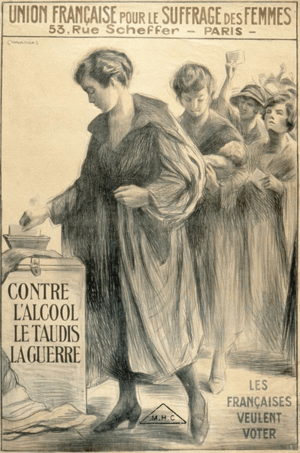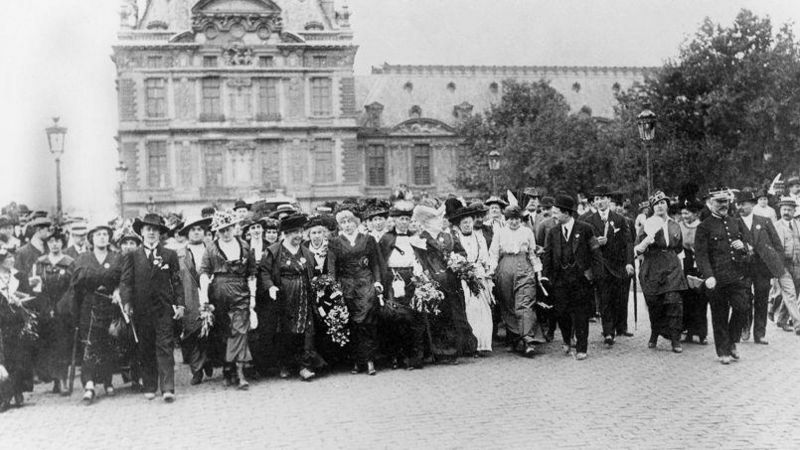French Union for Women's Suffrage facts for kids
|
French: Union française pour le suffrage des femmes
|
|

1909 poster: "French women want to vote - against alcohol, slums and war"
|
|
| Abbreviation | UFSF |
|---|---|
| Formation | 1909 |
| Dissolved | 1945 |
| Purpose | Obtain the franchise for women |
| Headquarters | Paris |
|
Region
|
France |
|
Official language
|
French |
|
Key people
|
Cécile Brunschwicg |
| Affiliations | International Woman Suffrage Alliance |
The French Union for Women's Suffrage (UFSF) was an organization in France. It was formed in 1909. The UFSF worked to get women the right to vote. This right was finally given to women in 1945.
The Union chose a calm and steady way to reach its goals. They suggested giving women the right to vote step-by-step. They wanted women to vote in local elections first. The UFSF also worked with men in the French Parliament who supported their cause.
How the UFSF Started
The UFSF was created by a group of women who believed in equal rights. They had attended a big meeting for French feminists in Paris in 1908. Most of these women came from well-off families or were highly educated.
The main leaders were Jane Misme and Jeanne Schmahl. Jane Misme was the editor of a newspaper called La Française. The UFSF offered a less aggressive choice than another group led by Hubertine Auclert.
The UFSF's only goal was to get women the right to vote using legal methods. This goal was shared in La Française in early 1909. About 300 women attended the first meeting in February 1909. Cécile Brunschvicg became the secretary-general. She was married to a famous philosopher.
The UFSF was officially recognized by the International Alliance of Women (IWFA). This happened at their meeting in London in April 1909. The IWFA saw the UFSF as the main group for women's voting rights in France.
Before World War I
The UFSF grew very quickly. Cécile Brunschwicg traveled around France, giving talks about women's rights. Many feminist school teachers also helped by starting local groups. Important women like Sarah Monod joined the UFSF. Jeanne Mélin and Louise Bodin also became members.
By 1914, the UFSF had 12,000 members. These members were spread across 75 different areas of France. The UFSF planned to work with members of Parliament who supported women's voting rights. One of these supporters was Ferdinand Buisson. Their plan was to slowly gain voting rights, starting with local elections.
Men in France had been able to vote since 1848. In February 1914, a law was proposed to let women vote too. This law would have extended the 1848 act to women. However, it did not pass in Parliament.
In April 1914, the UFSF took part in a special vote. This vote was organized by Marguerite de Witt-Schlumberger. Ballot boxes were placed in public places like newsstands. People could vote "I want to vote" or "No." Over 500,000 people voted "I want to vote." Only 114 voted "No."
The UFSF usually avoided big, loud protests. But they did join a large demonstration in Paris on July 5, 1914. About 6,000 people took part in this "Condorcet Demonstration." It was organized by a journalist named Séverine. This protest happened just weeks before World War I began.
After the War
The UFSF stopped its campaign for voting rights during World War I (1914–1918). They supported the French government during the war. After the war, many people thought women would get the right to vote. This was seen as a reward for their help during the war.
In 1919, the French Parliament did pass a bill to give women the right to vote. But the Senate, which is the upper house of Parliament, stopped the bill. The Senate continued to block the bill every time it was brought up again.
The Parliament voted for women's right to vote many times:
- May 20, 1919: 329 votes for, 95 against.
- April 7, 1925: 389 votes for, 140 against.
- July 12, 1927: 396 votes for, 94 against.
- March 21, 1932: 446 votes for, 60 against.
- March 1, 1935: 453 votes for, 124 against.
- July 30, 1936: 495 votes for, 0 against.
Each time, the Senate blocked the bill.
Because of the Senate's resistance, the UFSF worked with Louise Weiss for a short time. Louise Weiss was known for more active protests. But the UFSF mostly stayed moderate. They kept working with their supporters in Parliament.
Cécile Brunschwicg continued to lead the UFSF. The organization grew even more after 1922. By 1928, it had 100,000 members. In 1936, the Prime Minister, Léon Blum, made Brunschwicg a government official. She became the undersecretary for national education. Blum also tried to pass a voting rights bill in 1936, but the Senate blocked it again.
During World War II (1939–1945), the UFSF was not active. In 1944, General Charles de Gaulle finally gave women the right to vote. Because their main goal was achieved, Cécile Brunschwicg decided not to restart the UFSF.
See also
 In Spanish: el_Sufragio_Femenino Unión Francesa para el Sufragio Femenino para niños
In Spanish: el_Sufragio_Femenino Unión Francesa para el Sufragio Femenino para niños


